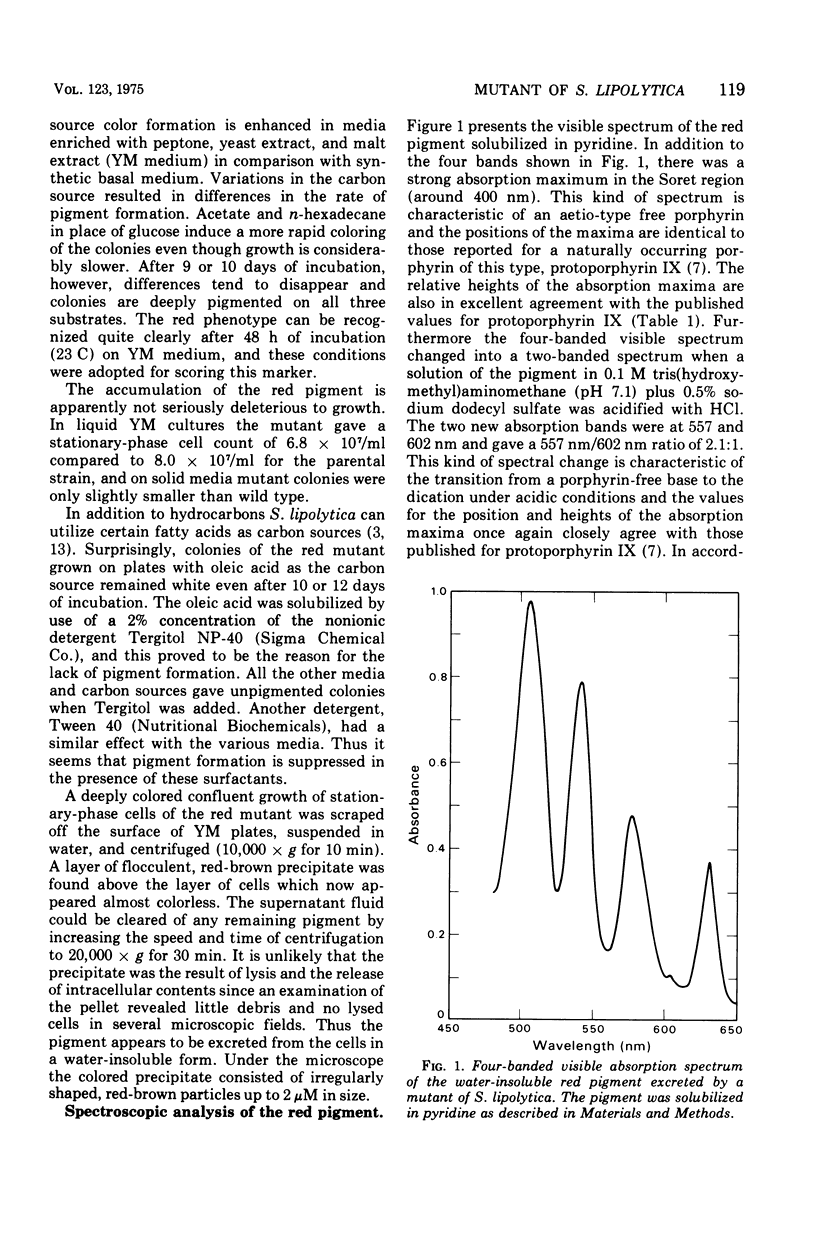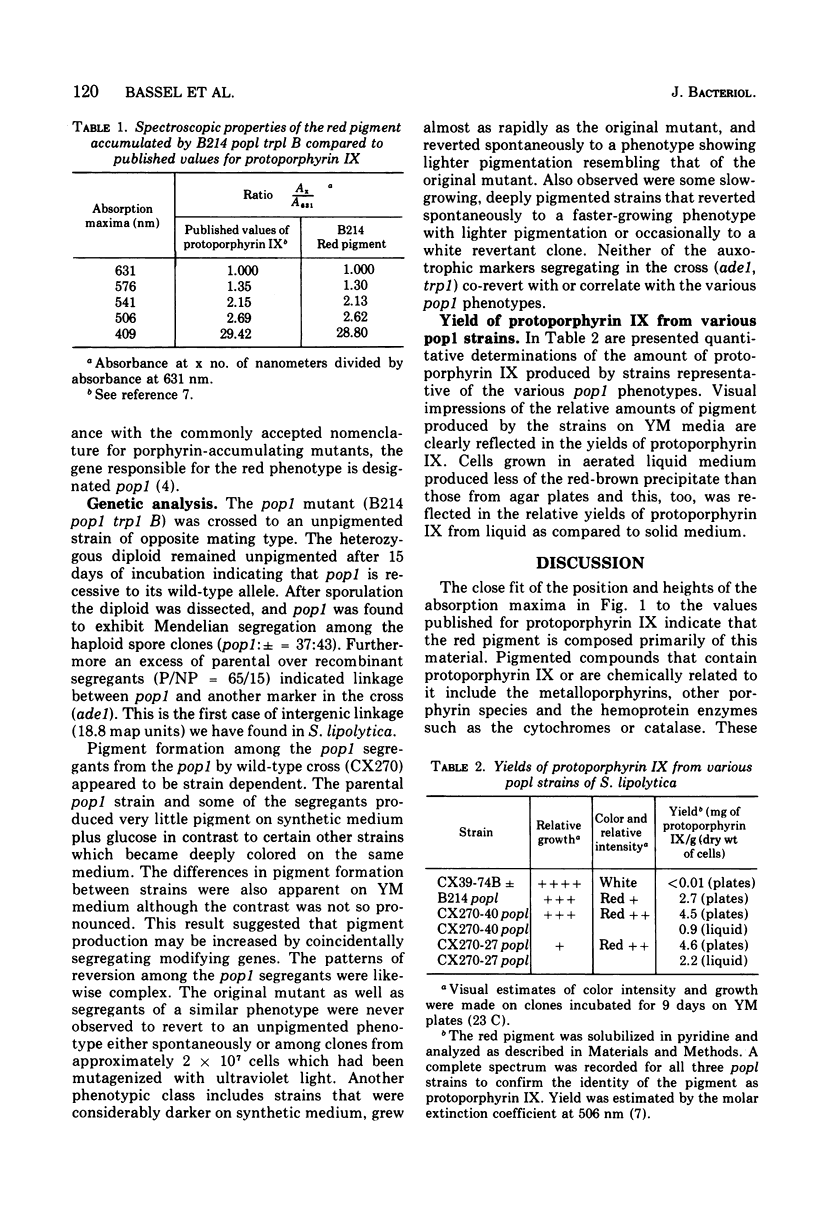Abstract
The red, water-insoluble pigment excreted by a mutant strain of the yeast Saccharomycopsis lipolytica is show to be protoporphyrin IX. In genetic crosses the red phenotype has the properties characteristic of a defect in a single, recessive nuclear gene. The yield and ease of harvest of protoporphyrin IX from the yeast mutant indicate that this strain or its derivatives may be a valuable source of this substance.
Full text
PDF




Selected References
These references are in PubMed. This may not be the complete list of references from this article.
- BASES R., BRODIE S. S., RUBENFELD S. Attempts at tumor localization using Cu 64-labeled copper porphyrins. Cancer. 1958 Mar-Apr;11(2):259–263. doi: 10.1002/1097-0142(195803/04)11:2<259::aid-cncr2820110206>3.0.co;2-2. [DOI] [PubMed] [Google Scholar]
- Bassel J., Mortimer R. Genetic analysis of mating type and alkane utilization in Saccharomycopsis lipolytica. J Bacteriol. 1973 May;114(2):894–896. doi: 10.1128/jb.114.2.894-896.1973. [DOI] [PMC free article] [PubMed] [Google Scholar]
- Bassel J., Warfel J., Mortimer R. Complementation and genetic recombination in Candida lipolytica. J Bacteriol. 1971 Oct;108(1):609–611. doi: 10.1128/jb.108.1.609-611.1971. [DOI] [PMC free article] [PubMed] [Google Scholar]
- Cox R., Charles H. P. Porphyrin-accumulating mutants of Escherichia coli. J Bacteriol. 1973 Jan;113(1):122–132. doi: 10.1128/jb.113.1.122-132.1973. [DOI] [PMC free article] [PubMed] [Google Scholar]
- Fawwaz R. A., Frye F., Loughman W. D., Hemphill W. Survival of skin homografts in dogs injected with 109Pd-protoporphyrin. J Nucl Med. 1974 Nov;15(11):997–1002. [PubMed] [Google Scholar]
- Fawwaz R. A., Hemphill W., Winchell H. S. Potential use of 109Pd-porphyrin complexes for selective lymphatic ablation. J Nucl Med. 1971 May;12(5):231–236. [PubMed] [Google Scholar]
- Lascelles J., Hatch T. P. Bacteriochlorophyll and heme synthesis in Rhodopseudomonas spheroides: possible role of heme in regulation of the branched biosynthetic pathway. J Bacteriol. 1969 May;98(2):712–720. doi: 10.1128/jb.98.2.712-720.1969. [DOI] [PMC free article] [PubMed] [Google Scholar]
- Miyake S., Sugimura T. Coproporphyrinogenase in a respiration-deficient mutant of yeast lacking all cytochromes and accumulating coproporphyrin. J Bacteriol. 1968 Dec;96(6):1997–2003. doi: 10.1128/jb.96.6.1997-2003.1968. [DOI] [PMC free article] [PubMed] [Google Scholar]
- Wickerham L. J., Kurtzman C. P., Herman A. I. Sexual reproduction in Candida lipolytica. Science. 1970 Feb 20;167(3921):1141–1141. doi: 10.1126/science.167.3921.1141. [DOI] [PubMed] [Google Scholar]
- Winkelman J., Slater G., Grossman J. The concentration in tumor and other tissues of parenterally administered tritium- and 14-C-labeled tetraphenylporphinesulfonate. Cancer Res. 1967 Nov;27(11):2060–2064. [PubMed] [Google Scholar]
- Yarrow D. Four new combinations in yeasts. Antonie Van Leeuwenhoek. 1972;38(3):357–360. doi: 10.1007/BF02328105. [DOI] [PubMed] [Google Scholar]


